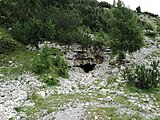Dinosaur tracks from Monte Buso
The dinosaur tracks from Monte Buso are fossil footprints left by theropods in the wet sediment of the late Lower Jurassic . The footprints are on the ceiling of the First World War created tunnel on the Pasubio - solid in Trentino , Italy .
description
During the First World War, the Pasubio was a hard-fought mountain on the Alpine front between Austria-Hungary and the Kingdom of Italy . The dinosaur tracks were discovered in 2010 by employees of the Trentino Natural Science Museum ( Italian: Museo tridentino di scienze naturali ) in Trento in a tunnel built by the Austro-Hungarian army on Monte Buso ( 2080 m slm ) north of the Campiluzzi East gap (Italian: Sella Est dei Campiluzzi ) discovered at an altitude of around 1980 m. The approximately 250 m long, 2.5 m wide and 2 m high tunnel was built between 1916 and 1918 and cuts through Monte Buso in an east-west direction. It served the Austro-Hungarian army as a safe supply route and is also known as the Stol dei Campiluzzi .
The footprints are about 130 m after the western tunnel entrance on the tunnel ceiling. These are three negative three- toed footprints about 30 cm in size , two of which are partially superimposed, which belong to two theropod tracks that were created at different times and were probably left by two dinosaurs. At the front ends the prints of the claws can partly be seen. From the trace taxonomy , the researchers concluded that they were medium-sized dinosaurs with a height of 2 m, a body length of 7 to 8 m and a weight of 400 kg. They assigned the tracks to the genus Dilophosaurus .
In addition to the footprints, fossils of ferns, conifers as well as mussels and fish were found in the tunnel .
meaning
The tracks were created in a swamp-like area filled with salt water, which was located in the Sinemurium on the edge of the Paratethys on the so-called Tridentine threshold . A carbonate platform that reached from Lake Garda to Monte Grappa and thus also included the area of today's Pasubio massif.
For a long time, research assumed that this area in the Lower Jurassic was predominantly below the surface of the water and only protruded from the water in places, similar to a watt . The dinosaur tracks on Monte Buso are finally shaking this model after Ichnofossils previously found in Trentino cast doubt on this theory. Because of these findings, the flooding of the platform has to be relocated to the Upper Jurassic by several million years .
The prints also show similarities with traces found in Poland, France, Scandinavia and North America, suggesting a land connection with the Eurasian continent. This is in contrast to the assumption that this area of the Alps in the Lower Jurassic was separated from Eurasia by a deep estuary.
literature
- Fabio Massimo Petti, Massimo Bernardi, Rossana Todesco, Marco Avanzini: Dinosaur footprints as ultimate evidence for a terrestrial environment in the late sinemurian Trento carbonate platform . In: Palaios Vol. 26 No. 9/19 (September-October 2011), Society for Sedimentary Geology .
Web links
- Dinosauri, orme rivoluzionarie (National Geographic Italia) (Italian)
- I dinosauri possono riscrivere i confini dell'Italia preistorica (corriere.it) (Italian)
- Tracce di dinosauro ridisegnano il giurassico italiano (ansa.it) (Italian)
Individual evidence
- ↑ Fabio Massimo Petti, Massimo Bernardi, Rossana Todesco, Marco Avanzini: Dinosaur footprints as ultimate evidence for a terrestrial environment in the late sinemurian Trento carbonate platform p. 601
- ^ Dinosauri, orme rivoluzionarie. Dilofosauri, i possibili autori delle orme. In: nationalgeographic.it. Retrieved July 31, 2019 (Italian).
- ↑ Fabio Massimo Petti, Massimo Bernardi, Rossana Todesco, Marco Avanzini: Dinosaur footprints as ultimate evidence for a terrestrial environment in the late sinemurian Trento carbonate platform p. 604
- ↑ Fabio Massimo Petti, Massimo Bernardi, Rossana Todesco, Marco Avanzini: Dinosaur footprints as ultimate evidence for a terrestrial environment in the late sinemurian Trento carbonate platform p. 605
- ^ Dinosauri, orme rivoluzionarie. Una nuova storia antica dell'Italia ... In: nationalgeographic.it. Retrieved July 31, 2019 (Italian).
- ↑ I dinosauri possono riscrivere i confini dell'Italia Preistorica. In: corriere.it. September 21, 2010, accessed August 1, 2019 (Italian).
Coordinates: 45 ° 48 '56 " N , 11 ° 10' 4.8" E



